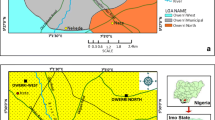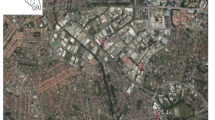Abstract
The economic downturn in Nigeria and Structural Adjustment Programme led to the flooding of Nigerian market with imported used automobiles. Most of these vehicles needed refurbishing and reworking. The present study is a human health risk assessment of metal exposure resulting from reworking of imported used vehicles in Nigeria. Scrap paint dusts from 56 Japanese made cars were collected from 8 different mechanic villages (workshops A–H] in Southeastern Nigeria. Scrap paints were homogenized, mixed, divided into fine particles and digested by standard method. The filtrates were assayed of lead, manganese and copper with atomic absorption spectrophotometry (AAS). Workshop B has the highest concentration of Pb (4.26 ± 0.93). Manganese in workshops A and F were (3.31 ± 0.85) and (3.04 ± 0.47) respectively and were higher than the levels from workshops C, B, D, G and H. Copper in workshop D (7.11 ± 0.21) was significantly greater than the other workshops. The highest hazard quotient (HQ) through ingestion, inhalation and dermal exposures in adults were 9.44E−05 (workshop B), 4.20E−01 (workshop B) and 1.08E−05 (workshop D) respectively. The highest values for HQ through ingestion, inhalation and dermal in children were 8.82E−04, 7.61E−01 and 2.86E−05 all in workshop B respectively. For children, the highest carcinogenic risk levels were 7.05E−08, 6.09E−05 and 2.29E−10 for ingestion, inhalation and dermal exposures respectively. In adults, the carcinogenic risk levels were 7.55E−09, 3.39E−05 and 8.67E−10 for ingestion, inhalation and dermal exposures respectively. Chronic exposure to scrap car paint dusts may be of significant public health importance in Nigeria as this may add to the body burden of some heavy metals.

Similar content being viewed by others
References
Ackerfor HS (1977) Mercury pollution in Sweden with special reference to conditions in the water habitat. Proc R Soc Lond 177(367):87
Agbo COA (2011) A critical evaluation of motor vehicle manufacturing in Nigeria. Niger J Technol 30(1):8–16
Alexander BH, Checkoway H, van Netten C, Muller CH, Ewers TH, Kaufman JD, et al. (1996) Semen quality of men employed at a lead smelter. Occup Environ Med 53:411–416
American Conference of Governmental Industrial Hygienists (ACGIH) (1985) Particle size-selective sampling in the workplace: report of the ACGIH technical committee on air sampling procedures. ACGIH, Cincinnati, pp. 65–76
Andersen ME, Gearhart JM, Clewell HJ (1999) Pharmacokinetic data needs to support risk assessment for inhaled and ingested manganese. Neurotoxicology 20:161–171
Armstrong CW, Moore LW Jr, Hackler RL, Miller GB Jr, Stroube RB (1983) An outbreak of metal fume fever. Diagnostic use of urinary copper and zinc determinations. J Occup Med 25:886–888
Aschner M, Erikson KM, Herrero Hernández E, Tjalkens RB (2009) Manganese and its role in Parkinson’s disease: from transport to neuropathology. Neruomol Med 11(4):252–266
ATSDR (Agency for Toxic Substances and Diseases Registry) 1990 Toxicological profile for copper prepared by Syracuse research corporation for ATSDR, US Pub. Health service under contract. 88 – 0608 – 2. ATSDR/TP – 90 – 08
DA C-S (1995) Relationships between lead induced learning impairments and changes in dopaminergic, cholinergic and glutamatergic neurotransmitter system functions. Annu Rev Pharmacol Toxicol 35:391–415
De Flora S, Camoirano A, Bagnasco M, et al. (1997) Estimates of the chromium(VI) reducing capacity in human body compartments as a mechanism for attenuating its potential toxicity and carcinogenicity. Carcinogenesis 18:531–537
De Miguel E, Iribarren I, Chacon E, Ordonez A, Charlesworth S (2007) Risk-based evaluation of the exposure of children to trace elements in playground in Madrid (Spain). Chemosphere 66:505–513
Ferreira-Baptista L, De Miguel E (2005) Geochemistry and risk assessment of street dust in Luanda Angola. A tropical urban environment. Atmos Environ 4(71):3–26
Filon FL, Boeniger M, Maino G, Adami G, Spinelli P, Damian A (2006) Skin absorption of inorganic lead (PbO) and the effect of skin cleansers. J Occup Environ Med 48(7):692–699
Filon FL, D’Agostin F, Crosera M, Adami G, Bovenzi M, Mariana G (2009) In vitro absorption of metal powders through intact and damaged human skin. Toxicol in Vitro 23(4):574–579
Gorner P, Fabries J-F (1996) Industrial aerosol measurement according to the new sampling conventions. Occup Hyg 3:361–376
Henn BC, Schnaas L, Ettinger AS, Schwartz J, Lamadrid-Figueroa H, Hernàndez-Avila MM, et al. (2011) Associations of early childhood manganese and lead coexposure with neurodevelopment. Environ Health Perspect 120:126–131
Hodgkins DG, Robins TG, Hinkamp DL, Schork MA, Levine SP, Krebs WH (1991) The effect of airborne lead particle size on worker blood-lead levels: an empirical study of battery workers. J Occup Med 33(12):1265–1273
Hostynek JJ (2003) Factors determining percutaneous metal absorption. Food Chem Toxicol 41(3):327–345
Hu X, Zhang Y, Luo J, Wang T, Lian H, Ding Z (2011) Bioaccessibility and health risk of arsenic, mercury and other heavy metals in urban street dusts from a mega-city, Nanjing, China. Environ Pollut 159
Kendall NR, McMullen S, Green A, Rodway RG (2000) The effect of a zinc, cobalt and selenium soluble glass bolus on trace element status and semen quality of ram lambs. Anim Reprod Sci 62(4):277–283
Laskey JW, Rehnberg GL, Hein JF, Carter SD (1982) Effects of chronic manganese (Mn3O4) exposure on selected reproductive parameters in rats. J Toxicol Environ Health 9(4):677–687
Lauwerys R, Roels H, Genet P, Toussaint G, Bouckaert A, DeCooman S (1985) Fertility of male workers exposed to mercury vapor or to manganese dust: a questionnaire study. Am J Ind Med 7:171–176
Li S, Zhang Q (2010) Risk assessment and seasonal variations of dissolved trace elements and heavy metals in the Upper Han River, China. J Hazard Mater 181:1051–1058
Liu X, Song Q, Yang Y, LI W, XU J, WU J, Wang F, Brookes PC (2013) Human health risk assessment of heavy metals in soil-vegetable system: a multi medium analysis. Sci Total 463:530–540
Maduabuchi JMU, Nzegwu CN, Adigbe EO, Aloke RU, Ezomike CN, Okocha CE, Obi E, Orisakwe OE (2006) Lead and cadmium exposures from canned and non-canned beverages in Nigeria: a public health concern. Sci Total Environ 366:621–621
Mbawike N 2007 7 million vehicles operate on Nigerian roads FRSC. Leadership Nigerian Muse. <http://www.nigerianmuse.com>
Meeker JD, Rossano MG, Protas B, Diamond MP, Puscheck E, Daly D, Paneth N, Wirth JJ (2008) Cadmium, lead, and other metals in relation to semen quality: human evidence for molybdenum as a male reproductive toxicant. Environ Health Perspect 116(11):1473–1479
Min KB, Mina JY, Chos I, Kim H, Pack DY (2008) Relationship between low blood levels and growth in children of white-collar servants in Korea. Int J Hyg Environ Health 211:82–87
Nduka JK, Orisakwe OE (2010) Assessment of environmental distribution of lead in some municipalities of South Eastern Nigeria. Int J Environ Res Public Health 7:2501–2513
Nduka JK, Nwaro CJ, Ezenwa TE (2008) Occupational exposure to lead poisoning, a public health concern. 31st International Annual Conference of the Chemical Society of Nigeria. 22nd–26th September. Book of Proceeding, 695–697
Neal AP, Guilarte TR (2012) Mechanism of heavy metal neurotoxicity: lead and manganese. J Drug Metab Toxicol S5(002):1–13
Orisakwe OE, Igwilo IO, Afonne OJ, Maduabuchi JMU, Obi E, Nduka JC (2006) Heavy metal hazards of sachet water in Nigeria. Arch Environ Occup Health 61(5):209–213
Orisakwe OE, Nwachukwu E, Osadolor HB, Afonne OJ, Okocha CE (2007) Liver and kidney function tests amongst paint factory workers in Nkpor; Nigeria. Toxicol Ind Health 23:161–168
Orisakwe OE, Nduka JK, Amadi CE, Dike D, Obialor O (2012a) Evaluation of potential dietary toxicity of heavy metals of vegetables. J Environ Anal Toxicol 2:136
Orisakwe OE, Nduka JK, Amadi CN, Dike DO, Bede O (2012b) Heavy metals health risk assessment for population via consumption of food crops and fruits in Owerri, South Eastern, Nigeria. Chem Cent J 6(77):1–14
Public Health and Environment Department 2007 Country profiles of environmental burden of disease [Internet]. World Health Organization, Geneva. [cited 2014 Feb 17]. Available from: http://who.int/quantifying_ehimpacts/national/countryprofile/intro/en/index.html
Quantifying environmental health impacts: data and statistics [Internet] (2014) World Health Organization, Geneva; c [cited 2007 Aug 11]. 1 p. Available from: http://www.who.int/quantifying_ehimpacts/en/
Roels HA, Ghyselen P, Buchet JP, Ceulemans E, Lison RA (1992) Permissible exposure level to manganese in workers exposed to manganese dioxide dust. Br J Ind Med 49(25):34
Sahni V, Léger Y, Panaro L, Allen M, Giffin S, Fury D, et al. (2007) Case report: a metabolic disorder presenting as pediatric manganism. Environ Health Perspect 115:1776–1779
Schwar MJR, Moorcroft JS, Laxen DPH, Thompson M, Armorgie C (1988) Baseline metal-in-dust concentrations in Greater London. Sci Total Environ 68:25–13
Solís-Vivanco R, Rodríguez-Agudelo Y, Riojas-Rodríguez H, Ríos C, Rosas I, Montes S (2009) Cognitive impairment in an adult Mexican population non-occupationally exposed to manganese. Environ Toxicol Pharmacol 28(2):172–178
Spangler AH, Spangler JG (2009) Groundwater manganese and infant mortality rate by county in North Carolina: an ecological analysis. EcoHealth 6(4):596–600
Sun CC, Wong TT, Hwang YH, Chao KY, Jee SH, Wang JD (2002) Percutaneous absorption of inorganic lead compounds. Am Ind Hyg Assoc J 63(5):641–646
Tumura T, Turnlund JR (2004) Effect of long-term, high copper intake on the concentrations of plasma homocysteine and B-vitamins in young men. Nutrition 20(9):757–759
U.S.Environmental Protection Agency 1996 Soil screening guidance. technical background document. EPA/540/R-95128. Office of Solid Waste and Emergency Response. U.S. Environmental Protection Agency. Washington D.C. http://www.epa.gov/superfund resource/soil/toc.htmllpl
US EPA (1985) Effect of pH, DIC, orthophosphate and sulfate on drinking water cupro solvency. EPA/600/R-95/085. US Environmental Protection Agency, Office of Research and Development, Washington DC
US EPA (1989) Risk assessment guidance for Superfund, vol. I: human health evaluation manual. EPA/540/1-89/002. Office of Solid Waste and Emergency Response
US EPA (1996) Soil screening guidance: technical background document. EPA/540/r-95/128. Office of Solid Waste and Emergency Response
US EPA (2001) Risk assessment guidance for superfund: volume III—part a, process for conducting probabilistic risk assessment. EPA 540-R-02-002. US Environmental Protection Agency, Washington, D.C.
US EPA (2002a) Calculating upper confidence limits for exposure point concentrations at hazardous waste sites. OSWER 9285.6-10. Office of Emergency and Remedial Response, U.S. Environmental Protection Agency, Washington, DC 20460
US EPA (2002b) Child specific exposure factors handbook. EPA-600-P-00-002B. National Center for Environmental Assessment, Washington, DC
USDOE (2011) The Risk Assessment Information System (RAIS). U.S. Department of Energy’s Oak Ridge Operations Office (ORO)
US EPA (2011a) Exposure factors handbook 2011 edition. EPA/600/R-09/052F. National Center for Environmental Assessment, Office of Research and Development, U.S. Environmental Protection Agency, Washington, D.C. 20460
US EPA (2011b) Section 2.4.1-1 Pages 51589-51590 of the HRS rule. http://ww.epa.gov//htmain/s 2411,htm. Assessed 08 Oct 2014
Van den Berg R (1995). Human exposure to soil contamination: a qualitative and quantitative analysis towards proposals for human toxicology intervention values. RIVM Report no. 725201011 National Institute of Public Health and Environmental Protection (RIVM) Bilthoven. The Netherlands. http://www.nvm.nl.bibliotheckrapporten.725201011.html
Walsh MP (2007) The global experience with lead in gasoline and the lessons we should apply to the use of MMT. Am J Ind Med 50:853–860
Wirth JJ, Rossano MG, Daly DC, Paneth N, Puscheck E, Potter RC, et al. (2007) Ambient manganese exposure is negatively associated with human sperm motility and concentration. Epidemiology 18:270–273
World health organization – WHO (1995) Environmental health criteria 165: inorganic lead. ONU, Geneva
Yokel PA (2009) Manganese flux across the blood-brain barrier. Neruomol Med 11:297–310
Zeng Q, Zhou B, Feng W, Wang YX, Liu AL, Yue J, Li YF, WQ L (2013) Associations of urinary metal concentrations and circulating testosterone in Chinese men. Reprod Toxicol (Elmsford, NY) 41:109–114
Zheng N, Liu J, Wang Q, Liang Z (2010a) Health risk assessment of heavy metal exposure to street dust in the zinc smelting district, northeast of China. Sci Total Environ 408:726–733
Zheng N, Liu J, Wang Q, Liang Z (2010b) Heavy metals exposure of children from stairway and sidewalk dust in the smelting district, northeast of China. Atmos Environ 44:3239–3245
Acknowledgment
We acknowledge the efforts of Mr. Vincent Nwaliegi Okafor in the collection of scrap car paint dust samples.
Author information
Authors and Affiliations
Corresponding author
Additional information
Communicated by: Philippe Garrigues
Rights and permissions
About this article
Cite this article
Nduka, J.K., Onyenezi Amuka, J.P., Onwuka, J.C. et al. Human health risk assessment of lead, manganese and copper from scrapped car paint dust from automobile workshops in Nigeria. Environ Sci Pollut Res 23, 20341–20349 (2016). https://doi.org/10.1007/s11356-016-7219-7
Received:
Accepted:
Published:
Issue Date:
DOI: https://doi.org/10.1007/s11356-016-7219-7




